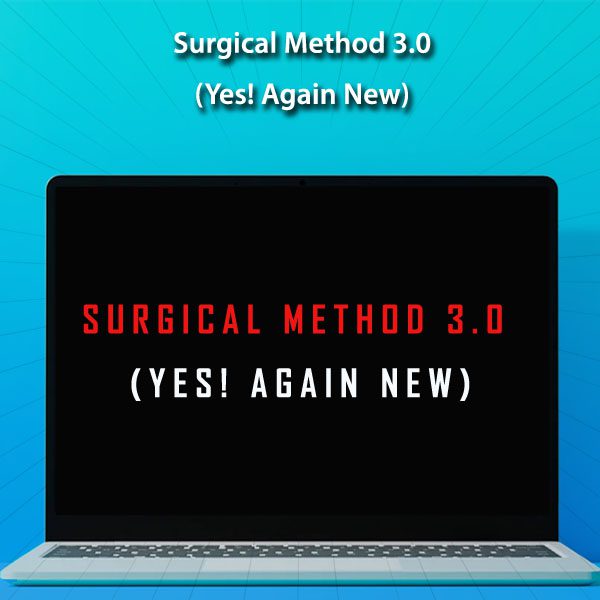Description
Download Proof | Surgical Method 3.0 (Yes! Again New) (35.04 GB)
![]()

Surgical Method 3.0: The Latest Evolution in Precision Surgery
The world of surgery is constantly advancing, and with it comes the introduction of cutting-edge techniques designed to improve patient outcomes, reduce recovery time, and enhance precision. Enter Surgical Method 3.0, a revolutionary approach that incorporates the latest technological advancements and refined methodologies for even better results. Yes, it’s new again, and this latest iteration marks a significant step forward in the field of modern surgery.
What is Surgical Method 3.0?
Surgical Method 3.0 is the latest development in minimally invasive and precision-guided surgical techniques. It builds on previous versions by integrating state-of-the-art robotics, artificial intelligence (AI), and enhanced imaging technologies to perform surgeries with greater accuracy, reduced invasiveness, and improved patient safety.
This method is designed for a wide range of procedures, from routine surgeries to complex, life-saving operations. Its versatility and precision are transforming the surgical landscape.
Key Innovations of Surgical Method 3.0
1. Advanced Robotic Assistance
While robotic surgery isn’t new, Surgical Method 3.0 introduces the latest generation of robotic systems that can perform intricate operations with unparalleled precision. These robots are now equipped with:
- AI algorithms that enhance decision-making and assist surgeons in navigating difficult anatomical structures.
- Haptic feedback technology that allows surgeons to “feel” tissue resistance remotely, improving accuracy and safety.
- Microsurgical capabilities, enabling operations that require delicate, fine motor control.
2. AI-Driven Preoperative Planning
AI and machine learning are playing an increasingly critical role in preoperative planning. Surgical Method 3.0 integrates AI-powered analysis of imaging data (CT, MRI, X-ray), allowing surgeons to:
- Identify the optimal surgical path with greater accuracy.
- Predict and avoid potential complications using historical data patterns.
- Customize procedures for individual patients, improving outcomes and reducing unnecessary tissue trauma.
3. Real-Time 3D Imaging and Augmented Reality (AR)
Surgical Method 3.0 incorporates advanced 3D imaging and AR tools that provide real-time, high-definition visuals of the surgical area. This allows surgeons to:
- Visualize internal structures in 3D, improving their spatial awareness during procedures.
- Overlay digital guides directly onto the patient’s anatomy using AR, helping surgeons make precise incisions and movements.
- Navigate through complex anatomy with virtual markers, improving safety during surgery.
4. Minimally Invasive Approaches
The latest version continues to push the boundaries of minimally invasive surgery (MIS), focusing on:
- Smaller incisions, leading to faster recovery times and less postoperative pain.
- Reduced scarring and infection risk, thanks to improved tools and techniques.
- Shorter hospital stays, with many procedures shifting from inpatient to outpatient settings.
5. Enhanced Postoperative Recovery Protocols
Surgical Method 3.0 doesn’t just improve the operation itself—it also focuses on postoperative care. By minimizing trauma during surgery, patients experience:
- Faster recovery and rehabilitation times.
- Less reliance on postoperative pain medications.
- Improved long-term outcomes with fewer complications.
Key Benefits of Surgical Method 3.0
1. Increased Precision
The integration of AI, robotics, and augmented reality allows surgeons to perform more precise surgeries. This reduces human error and ensures more consistent results.
2. Lower Risk of Complications
Thanks to the minimally invasive techniques and real-time data analysis, there is a significant reduction in the risk of infection, bleeding, and other postoperative complications.
3. Faster Recovery
Surgical Method 3.0 leads to quicker healing times. With smaller incisions and better tissue management, patients can return to their daily lives much sooner than with traditional methods.
4. Broader Application
This method can be applied across various fields of surgery, including orthopedics, neurosurgery, cardiovascular surgery, and oncological procedures. Its flexibility makes it a universal tool for surgeons across disciplines.
5. Personalized Surgery
By leveraging AI for preoperative planning, Surgical Method 3.0 provides personalized solutions tailored to each patient’s unique anatomy and condition, improving overall outcomes.
Examples of Surgical Method 3.0 in Action
1. Neurosurgery
In neurosurgery, precision is critical. Surgical Method 3.0 allows neurosurgeons to operate in highly sensitive areas of the brain with unprecedented accuracy, reducing the risk of damage to surrounding tissues and improving patient outcomes in cases like tumor removal or aneurysm clipping.
2. Cardiac Surgery
For complex heart surgeries, this method improves outcomes by offering real-time imaging, precise robotic incisions, and faster recovery. Procedures like valve repair or coronary artery bypass grafting (CABG) can now be performed with less risk of complications and shorter hospital stays.
3. Orthopedic Surgery
Surgical Method 3.0 is transforming joint replacement and reconstruction surgeries. With robotics and AI, surgeons can make ultra-precise cuts and placements, improving the longevity of implants and reducing the risk of revision surgeries.
The Future of Surgery: What’s Next?
As Surgical Method 3.0 continues to evolve, expect further innovations in areas such as:
- Nanotechnology to allow for even less invasive procedures.
- 5G connectivity, enabling real-time data transfer between surgeons and AI systems for remote-assisted surgeries.
- AI advancements that provide predictive diagnostics, helping surgeons make decisions with even more confidence.
Conclusion: The Surgical Revolution Continues
Surgical Method 3.0 is the future of precision surgery, offering enhanced safety, faster recovery, and personalized care. As this technology continues to advance, patients can look forward to a new era of surgery that delivers better outcomes with less pain and fewer complications. Whether you’re a patient or a medical professional, this latest innovation in surgery is worth watching closely as it reshapes the future of healthcare.













